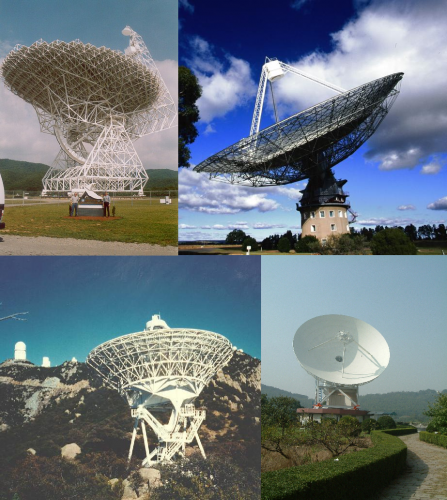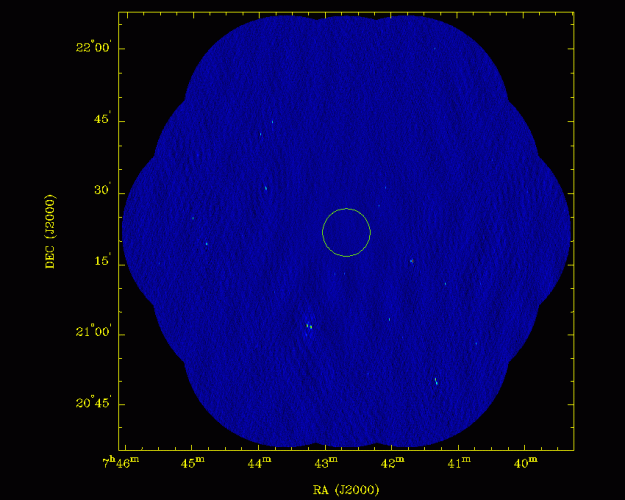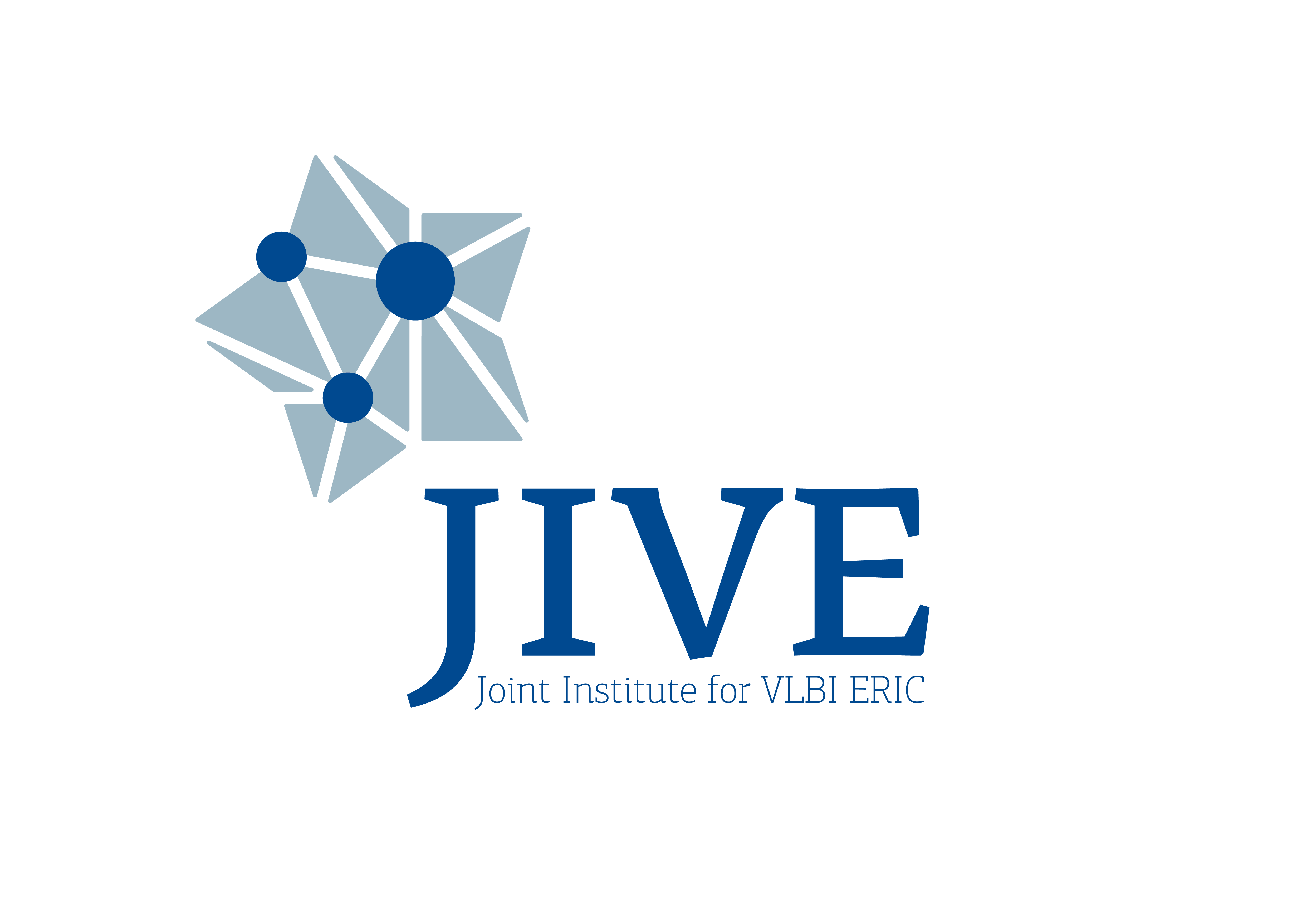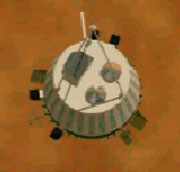
Above: Several radio telescopes of the Huygens VLBI tracking network (from top-left clockwise): 100-m R.C.Byrd Radio Telescope at Green Bank (NRAO, USA; photo by V.Gurvits), 70-m Parkes Radio Telescope (ATNF, Australia; photo by S.Duff), 25-m Radio Telescope at Sheshan (Shanghai Astronomical Observatory, PR China; photo courtesy X.Hong), 25-m VLBA Radio Telescope at Kitt Peak (NRAO, USA; photo courtesy NRAO).
When the Huygens Probe makes its plunge into the atmosphere of Saturn's moon Titan on 14 January 2005, a network of radio telescopes located in Australia, China, Japan and the USA connected to the Data Processing centre at the Joint Institute for VLBI in Europe (JIVE) in the Netherlands will help international teams of scientists extract the maximum possible amount of irreplaceable information from an experiment unique in human history. Huygens is the 340-kg probe that has accompanied the larger Cassini spacecraft on a mission to thoroughly explore Saturn, its rings and its numerous moons. Both spacecraft began their journey in October 1997.
Fig. 1: ESA's Huygens Probe
ESA scientists have teamed up with a large international collaboration of radio astronomers led by a team from JIVE, located in Dwingeloo, The Netherlands, to develop a technique conduct an experiment which is expected to collect unique information from the Huygens probe during its descent through Titan's atmosphere. They intend to use a technique called Very Long Baseline Interferometry (VLBI) to pick-up the probe's faint radio signal here on Earth and use it for reconstruction .of the trajectory of descent of the probe in the atmosphere of Titan.
As the Huygens probe parachutes down to the surface of Titan, it beams its radio signal to the Cassini orbiter flying overhead. Cassini will be pointing its high-gain antenna towards Titan to receive the Huygens data and to measure the Doppler shift of the received signal. The latter will be used for measurements of the radial velocity of the probe along the line connecting Cassini and Huygens. . A few hours later, Cassini must turn its high-gain antenna away from Titan and relay the Huygens data back to Earth. However, the very faint Huygens signal itself will also reach Earth, but only 72 minutes after the descent, this delay being due to the distance.
Working with partners and organisations in Europe, the USA, Australia, China and Japan, the team is preparing to use the ESA's Huygens team aim to use a technique so-called Very Long Baseline Interferometry (VLBI) technique to pick up the probe's faint radio signal here on Earth. The ESA project jointly coordinated by is being fully co-ordinated withESA and JIVE involves the Netherlands Foundation for Research in Astronomy (ASTRON, The Netherlands), University of Bonn (Germany), Helsinki University of Technology (Espoo, Finland), NASA Jet Propulsion Laboratory (Pasadena, USA), National Radio Astronomy Observatory (NRAO, Green Bank, WVA, and Socorro, NM, USA), Australia Telescope National Facility (ATNF, Epping, Australia), University of Tasmania (Hobart, Australia), National Astronomical Observatories of China and Shanghai Astronomical Observatory (Shanghai and Urumqi, PR China) and the National Institute of Information and Communications Technologies (Kashima Space Research Center, Japan).
The angular resolution of a particular telescope depends on two main parameters: its diameter and the wavelength of the signal it is receiving. The bigger larger the telescope and the shorter the wavelength, the better the angular resolution. However, there are physical limitations to the size of a telescope, while the wavelength of interest in many cases cannot be chosen arbitrarily. and, for optical telescopes at least, the optics must be very precisely shaped To get around this limitation, radio astronomers use the technique known as interferometry to match and surpass the highest resolutions obtained at other domains of electromagnetic spectrum (e.g. optical). This involves linking antennas together to act like as a single large radio telescope. The angular resolution of the resulting image is as good as that obtained from a single antenna with a diameter equal to the largest separation (or baseline) between the individual antennas.
The VLBI technique "the ultimate case of interferometry" was originally developed in the 1960s by astronomers who were seeking ways to push the angular resolution of radio telescopes to the limits for studies of distant celestial objects. Its record high angular resolution exceeds by far the "sharpness" of any other measurement technology available to date. In addition, by "phasing-up" telescopes at various locations, radio astronomers effectively increase collecting area of the receiving antenna thus increasing the sensitivity of the "synthesized" telescopes. Combined, these two properties make the VLBI technique the sharpest and the most sensitive tool for receiving cosmic radio signals of natural or human-made origin.
The VLBI technique requires the a co-ordinated use of an array of radio telescopes located thousands of kilometres apart from each other. The signals received at each telescope are recorded and sent for processing at a special correlation facility. In the case of Huygens VLBI tracking, data from about twenty radio telescopes located in Australia, China, Japan , Oceania and the United States will be processed at the European VLBI Network (EVN) Data Processor at JIVE in Dwingeloo, The Netherlands.
VLBI tracking of Huygens during its parachute descent in the atmosphere of Titan will allow observers to reach an unprecedented accuracy of about one kilometre in the determination of the probe's position. And this is at the distance between Earth and Titan of 1.2 billion kilometres! "Such angular resolution would allow sport fans to watch a trajectory of a table tennis ball if the game is played by the Apollo crew on the Moon surface" says Dr. Leonid Gurvits of JIVE, the project manager of the Huygens VLBI Tarcking experiment. "It is important to underline that such fantastic accuracy is not the goal in its own" continues Gurvits. "It will bring new possibilities for interpreting data from other on-board devices of the Huygens Probe and will place various measurements on the same standard coordinate reference frame".
The Huygens VLBI tracking experiment requires the application of VLBI techniques and technology in their most extreme form. This is why in the run up to the Huygens atmosphere entry scheduled for 14 January 2005, a number of "local" and "global" tests and dry runs were conducted. In particular, on 27 August and 17 November 2004, the Huygens VLBI tracking team conducted test observations using the carrier signal from the Cassini and Mars Express spacecraft as training "beacons".
Telescopes in China (Shanghai and Urumqi), the Netherlands (Westerbork), USA (NRAO's Robert C. Byrd Green Bank Telescope and eight VLBA stations), five radio telescopes in Australia (Ceduna, Hobart, Mopra, Parkes and the Australia Telescope Compact Array) and Japan (Kashima) were involved in these tests. In many senses the tests marked the highest points of VLBI technical achievements to date. For example, for the first time disk-only recording was used with the highest data rate of 512 Mbit/s using the largest steerable radio telescope on the planet, the NRAO's 110-m R.C.Byrd Green Bank radio telescope. The data obtained in the test are being analysed using special software tools developed at JIVE for the Huygens VLBI tracking experiment. The tests resulted in detection of the Cassini and Mars Express narrow-band carrier signals with sub-Hz spectral resolution (in the so called "autocorrelation" mode of data processing) and interferometric response (in the so called "interferometric fringes") on all baselines to all telescopes in cross-correlation mode. At the time of writing, fine-tuning of the data processing algorithms continues in order to achieve the best possible performance in the real event of 14 January 2005.

Fig. 3: A radio image of the Huygens Field - a region of the sky centered around the position of Titan on 14 January 2005. The image was obtained with the Australia Telescope Compact Array on 24 Nov 2004 at a wavelength of 13 cm (courtesy H. Bignall).
The Huygens VLBI tracking experiment shows an example of synergies between experimental techniques developed in fundamental astrophysics based on advanced technologies of radio physics, quantum electronics, digital signal processing, and planetary science, exploration of the Solar System by deep space probes. This synergy is the first step in future novel applications of VLBI for planetary missions of the coming decades.
The Joint Institute for VLBI in Europe is funded by the national research councils, national facilities and institutes of The Netherlands (NWO and ASTRON), the United Kingdom (PPARC), Italy (CNR), Sweden (Onsala Space Observatory, National Facility), Spain (IGN) and Germany (MPIfR). The European VLBI Network is a joint facility of European, Chinese, South African and other radio astronomy institutes funded by their national research councils. National Radio Astronomy Observatory is operated by Associated Universities, Inc., under a cooperative agreement with the National Science Foundation. The Australia Telescope is funded by the Commonwealth of Australia for operation as a National Facility managed by CSIRO.
Media Contacts
Dr. Leonid Gurvits, Joint Institute for VLBI in Europe
P.O. Box 2, 7990 AA Dwingeloo: lgurvits@jive.nl
The Netherlands phone: +31-(0)521-59651
Dr. Mike Garrett, Joint Institute for VLBI in Europe
Dwingeloo, The Netherlands garrett@jive.nl
phone: +31-(0)521-596500
Dr. Huib van Langevelde, Joint Institute for VLBI in Europe
Dwingeloo, The Netherlands langevelde@jive.nl
phone: +31-(0)521-596500
David Finley, National Radio Astronomy Observatory
Socorro, NM, USA dfinley@nrao.edu
phone: +1-505-835-7302
Dr. Chris Phillips, CSIRO Australia Telescope National Facility
Epping, N.S.W. Chris.Phillips@csiro.au
Australia phone: +61-2-9372-4608

